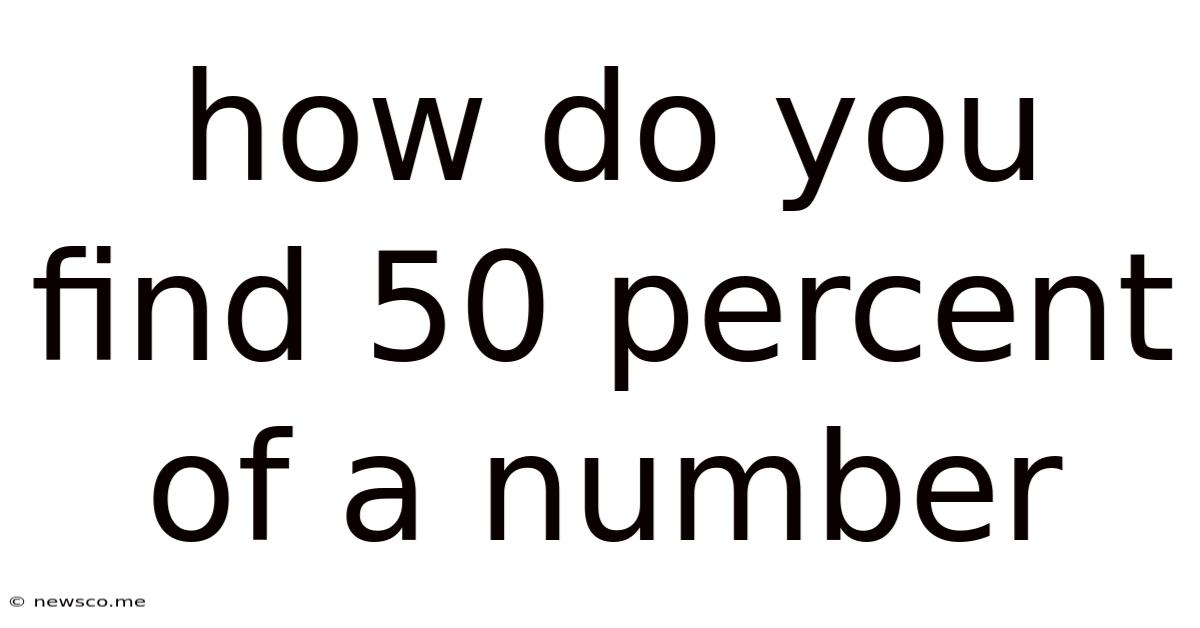How Do You Find 50 Percent Of A Number
News Co
May 02, 2025 · 4 min read

Table of Contents
How Do You Find 50 Percent of a Number? A Comprehensive Guide
Finding 50 percent of a number is a fundamental mathematical concept with widespread applications in everyday life, from calculating discounts to understanding statistics. While seemingly simple, understanding the different methods for calculating 50 percent offers valuable insights into percentages and their practical uses. This comprehensive guide explores various approaches, providing a solid foundation for anyone looking to master this essential skill.
Understanding Percentages
Before delving into the methods, let's establish a clear understanding of percentages. A percentage is a fraction or ratio expressed as a number out of 100. The symbol "%" represents "per cent" or "out of one hundred." Therefore, 50% means 50 out of 100, which simplifies to 1/2 or 0.5. This equivalence is crucial for understanding the various calculation methods.
Method 1: Dividing by 2
The simplest and most efficient method for finding 50 percent of a number is to divide it by 2. Since 50% is equivalent to 1/2, dividing a number by 2 directly yields its 50 percent value.
Example:
To find 50% of 120, simply divide 120 by 2:
120 / 2 = 60
Therefore, 50% of 120 is 60.
This method is particularly useful for mental calculations and situations where speed and efficiency are paramount. Its simplicity makes it ideal for quick estimations and everyday applications.
Advantages of Dividing by 2:
- Speed and Efficiency: This is the fastest method for calculating 50%.
- Simplicity: Easily understandable and applicable, even without advanced mathematical knowledge.
- Mental Calculation: Suitable for quick mental calculations, minimizing the need for calculators.
Method 2: Multiplying by 0.5
Another effective method involves multiplying the number by its decimal equivalent, 0.5. Since 50% equals 0.5, multiplying the number by 0.5 produces the same result as dividing by 2.
Example:
To find 50% of 250, multiply 250 by 0.5:
250 x 0.5 = 125
Therefore, 50% of 250 is 125.
This method is particularly useful when using calculators or spreadsheets, offering a consistent approach for various percentage calculations.
Advantages of Multiplying by 0.5:
- Calculator Friendliness: Easily performed using calculators or spreadsheet software.
- Consistency: A consistent method applicable to other percentage calculations.
- Formal Approach: Provides a more formal and mathematically rigorous approach.
Method 3: Using Proportions
For a more in-depth understanding, the concept of proportions can be employed. A proportion establishes a relationship between two ratios. In this case, we can set up a proportion to find 50% of a number:
50/100 = x/Total Number
Where 'x' represents 50% of the total number. Solving for 'x' provides the desired value.
Example:
To find 50% of 300:
50/100 = x/300
Cross-multiplying:
50 * 300 = 100 * x
15000 = 100x
x = 15000 / 100
x = 150
Therefore, 50% of 300 is 150.
While this method is more elaborate, it strengthens the understanding of percentages as ratios and provides a foundation for solving more complex percentage problems.
Advantages of Using Proportions:
- Conceptual Understanding: Reinforces the understanding of percentages as ratios.
- Foundation for Complex Problems: Provides a solid basis for solving more challenging percentage problems.
- Flexibility: Applicable to a wider range of percentage calculations.
Method 4: Using Fractions
Since 50% is equivalent to the fraction 1/2, we can also find 50% of a number by multiplying it by 1/2. This method is conceptually similar to dividing by 2 but uses a fractional representation.
Example:
To find 50% of 400:
400 x (1/2) = 200
Therefore, 50% of 400 is 200.
This method offers a visual and intuitive understanding of the concept, highlighting the relationship between fractions and percentages.
Advantages of Using Fractions:
- Visual Representation: Provides a visual and intuitive understanding of the calculation.
- Conceptual Clarity: Highlights the relationship between fractions and percentages.
- Alternative Approach: Offers an alternative method for solving 50% problems.
Real-World Applications of Finding 50%
The ability to quickly and accurately calculate 50% of a number has numerous real-world applications:
- Sales and Discounts: Determining the discount amount on a sale item offering a 50% discount.
- Tip Calculation: Estimating a 50% tip for exceptional service in a restaurant.
- Financial Planning: Calculating 50% of a budget for specific expenses.
- Data Analysis: Determining the midpoint in a dataset or representing half of a total value.
- Recipe Adjustments: Halving a recipe by finding 50% of each ingredient quantity.
- Splitting Bills: Fairly splitting costs with a friend or partner by calculating 50% of the total amount.
Beyond 50%: Expanding Your Percentage Skills
Understanding how to find 50% lays a solid foundation for calculating other percentages. By mastering the principles outlined above – using decimal equivalents, proportions, or fractions – you can easily adapt these techniques to calculate any percentage. Practice makes perfect, so regularly work through various percentage problems to build confidence and efficiency.
Conclusion: Mastering the 50% Calculation
Finding 50% of a number is a fundamental skill with broad applicability. While the simplest method is dividing by 2, understanding the alternative approaches – multiplying by 0.5, using proportions, and employing fractions – provides a deeper understanding of percentages and their underlying principles. This knowledge empowers you to solve various real-world problems quickly and confidently, enhancing your mathematical skills and problem-solving abilities in numerous contexts. By mastering this seemingly simple calculation, you open doors to a wider understanding of mathematical concepts and their practical application in everyday life.
Latest Posts
Related Post
Thank you for visiting our website which covers about How Do You Find 50 Percent Of A Number . We hope the information provided has been useful to you. Feel free to contact us if you have any questions or need further assistance. See you next time and don't miss to bookmark.